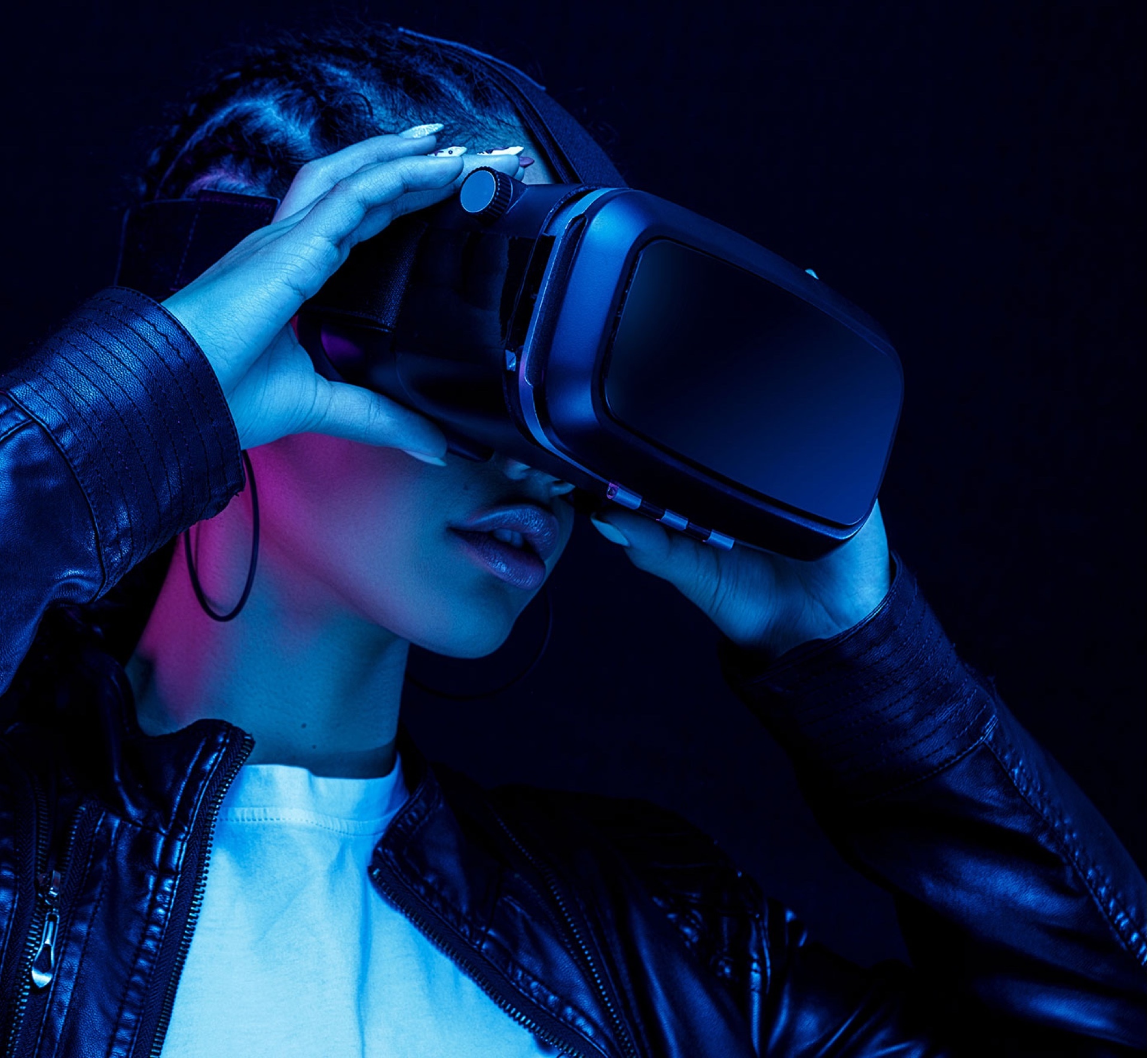The metaverse, NFTs and influencers: everything you need to know
- Influencer marketing
The metaverse, NFTs and the new guard of influencers. A summation of buzzwords? Or the next big thing? You probably already know about Facebook’s rebrand to the “future-proof” Meta. In any case, the rise of the metaverse is being handled big time by Marc Zuckerberg. Is this movement a must follow and do you take advantage of it as an early adopter? Or is it better to let it pass you by, just like Google Glass and Second Life? In this blog we tell you about the metaverse, NFTs and the role of influencers. Let’s go!
What is the metaverse?
There are several stories going around about what the metaverse is and what its possibilities are. The term “metaverse” was first used in a 1992 cyberpunk novel by Neal Stephenson, Snow Crash. Stephenson describes the metaverse as a shared “imaginary realm” that is “made available to the public through the global fiber optic network” projected onto virtual reality goggles. But it is much more than that.
The metaverse is not simply a “virtual space” like Second Life was. That would give the metaverse too little credit. Rather, the metaverse is a kind of parallel universe: it is a reflection of the real world, but in an online format. The world of the metaverse plays out for everyone in real time and synchronously. You could think of it as a three-dimensional form of the Internet. The metaverse is also known as Web 3.0.
How does the metaverse work?
The metaverse can be divided into two types:
Through platforms like Decentraland or The Sandbox, you buy a piece of land with NFTs or cryptocurrencies on which you can set up your own metaverse. Some metaverses are very realistic, others are more reminiscent of Habbo Hotel.
The other kind are metaverse that Facebook aspires to: a large virtual world where people can meet for meetings, socializing and general “enjoyment”.
You can do all sorts of things in a metaverse, although that depends on what the creator builds for you. You can do anything from shopping and going to concerts to meeting people or hosting business meetings. Trade in your NFTs for access to a concert or buy land with cryptocurrencies.
Does the metaverse already exist?
For now, there is no such thing as “the metaverse”. Currently, it is an accumulation of separate virtual communities. Examples include Minecraft, Roblox, Fortnite, Coinbase, The Sandbox, Decentraland and Facebook Horizon. The metaverse is still in its infancy. As you can imagine, it is quite a technical feat. We’re just laying the technical foundation.
The metaverse grew in popularity due to the global pandemic and is considered a real game-changer for home workers. In Horizon Workrooms, a free beta from Facebook, you meet your colleagues in a virtual meeting room. Just like a “real” meeting, you can write on a whiteboard, brainstorm ideas and type on your keyboard. Only without legs, because they haven’t been programmed yet.
Sogeti takes you into the wonderful world of the metaverse through their Metacast: a podcast in Horizon Workrooms. A nice move, because as a viewer you immediately see what they are talking about and what Horizon Workrooms looks like.
How would that look like? Take a look at the Metacast.
Meeting each other in the metaverse
If you can meet in a meeting room, you can also see each other in cooler places (sorry office people). Think about events and concerts. We always say: go to where the party is. In marketing slang that’s: go to where your target audience is. Is that Instagram? TikTok? According to Gucci, that’s at Roblox, an online gaming platform in the metaverse. The fashion giant has a digital-first policy and certainly has a taste for it: the Gucci Garden in Roblox attracted nearly 20 million visitors. Have you guessed who the target audience was? (It starts with the G and ends in ‘and Z’, read: Gucci’s future buyers).

Celebrating 100 years of Gucci in the Gucci Garden
Evening walk in the Vondelpark? Gucci has other plans and takes you into the Gucci Garden. To celebrate its 100th anniversary, Gucci had the exhibition in Florence digitally redesigned on the platform Roblox. Just like the real-life exhibition itself, the experience in Roblox consists of different rooms, each with a theme. Visitors are inspired by the imaginative mind of Creative Director Alessandro Michele.
You enter the virtual exhibition in the form of a neutral mannequin. There is also a store where visitors can purchase exclusive, limited-edition avatar items. These items are inspired by the signature Gucci items from the regular campaigns. Normally, these regular campaigns, think fashion shows, are quite inaccessible to many people. However, on virtual premises, everyone is welcome.
The impact of influencers in the metaverse
Where influencers go, their following follows. And this is also how the role of influencers in the metaverse is structured, under the heading ‘metafluence’. With the power of a magnet, they attract visitors to new online hotspots. That’s how it went with social networks and that’s how it will go in the metaverse. If you consider the metaverse – Web 3.0 – as a three-dimensional form of social platforms – or Web 2.0 – the role of influencers here is also immense. The question is no longer whether to hop on the bandwagon as a brand, but when.
But how big is the impact of influencers now? Travis Scott performed in Fortnite and earned some $20 million with a concert that lasted only 11 minutes. By comparison, his entire real-life tour made about 53 million. The sale of real-life and virtual merchandise, made this metaverse concert a huge success.
Is there still a dividing line between the online and physical worlds?
Will the metaverse become a kind of Madame Tussaud where you can spot virtual celebrities? We’ll see about that. The potential of the metaverse is almost infinite, but certainly depends on how ‘happening’ it is.
What we do know is that Millennials and Gen Z do not make a strict distinction between the digital and physical world. In their eyes, they are intertwined. After all, the younger generations grew up with Augmented Reality in Snapchat and Pokémon Go. Young people today spend more than 4 hours online. Add a dimension to Web 2.0 and you get into the metaverse: the online experience can only improve in this regard.
Virtual influencers in the metaverse
We can’t exactly predict if the impact of virtual influencers in the metaverse is going to be as big as Elon Musk’s influence on Dogecoin, but within influencer marketing it’s still a pretty big deal. Combine that with the potential of NFTs and the possibilities are endless.
Need a heads-up on what exactly NFTs are and what you can do with them? Then read our blog about NFTs and their potential.
In the metaverse you can meet your virtual heroes. After all, they appear more easily in the metaverse than on our good old planet earth (#consciousness). And now those NFTs: as we already told you in this blog, NFTs (non-fungible token) are a kind of digital certificate of ownership that can be exchanged on the blockchain network. In normal human language that is: you have licked digital artwork and an nft is the unique proof that it is yours. In the public blockchain, everyone sees who owns a particular token.
How we already notice the influence of the metaverse:
Real-life influencers are wearing virtual clothes, which puts a big fat line under the disappearing distinction between on- and offline;
Virtual influencers are gaining popularity among different audiences;
Virtual influencers have higher engagement rates than real-life influencers;
Major brands such as Facebook, Nike, Gucci and even Burger King are betting on the metaverse
Want to know more about virtual influencers? Read our blog on how virtual influencers are taking over from real-life influencers.
Parasocial relationship or paradoxical relationship?
‘Traditionally’, the relationship between influencer and viewer is rather one-sided, or ‘parasocial’, with a fancy term. The viewer knows who the influencer is, what he/she/them is concerned with and perhaps also what setbacks that person is facing. This applies to a much lesser degree the other way around: the influencer knows little or nothing about who the viewer is and what concerns them. Although livestreams, for example, have changed this recently, it remains an impossible task for the influencer. Especially when it comes to a following of millions.
So why do we follow virtual influencers en masse? In fact, they are not even a person and have no emotions, not to mention empathy. The relationship between viewer and influencer is beginning to take the form of a “paradoxical relationship. But this is not entirely justified. In our article on virtual influencers, we told you about Lil Miquela and her millions of followers. Virtual influencers are more than capable of building a community and entering into relationships with their followers. And that relationship is perhaps even deeper than with real-life influencers using NFTs.
NFTs in the context of virtual influencer marketing
Because an NFT is a digital piece of property, you can have the fan base of a virtual influencer buy co-ownership. Think of it as a share in a company: investors then own a piece of the company. Unlike shares, virtual influencers do not – for now – pay dividends. The co-ownership can, for example, give the fan base voting rights on what content the virtual influencer will create. This is more difficult with “real-life” influencers. For the record: you can’t just buy them 😉
Commit to NFTs
Is your brand a pioneer in the digital field? Then you better make a bet on NFTs and enter the metaverse before the competition does. There are different strategies on how to checkmate the competition, but it does depend on how you are positioned as a brand.
Luxury Italian shoe brand Cult & Rain deployed Discord to create hype around the launch of their first official presale. From their digital first approach, they found Discord to be a more appropriate platform than Instagram or TikTok. On Discord, you buy a 3D animated – collectable – of the shoes as NFT, with only 100 pairs of each ‘skin’ available. Since on Meta, formerly Facebook, this functionality does not yet exist, this emphasizes the exclusive nature of Cult & Rain.
Burger King is also betting on NFTs: the Real Meal NFT to be exact. On some 6 million Burger King burger boxes is a QR code with the possibility of unlocking a digital collectable. Have you collected enough of them? Then you have a once-in-a-lifetime chance to call one of the celebrities promoting the campaign. And these are not just any names: rapper Nelly, LILHUDDY and Anitta!
Benefits NFTs:
One of the biggest advantages of NFTs is the ability to retain all rights to artwork. Something that still causes a lot of frustration today for – let’s be real – just about everyone in the creative industry.
Collectables, as from the example of Cult & Rain, are unique because of NFTs. This uniqueness makes them increasingly valuable.
NFTs allow the creator to make money directly from their work. They rely less on intermediaries to sell their work online.
Provide demand creation and additional sales opportunities through hype around pre-sales and virtual merchandise.
Community: through the creative use of NFTs you can give your community voting rights on certain issues, or increase the engagement of campaigns by using NFTs to unlock certain perks – meet & greet, free access to events.
Luxury brands are often at the forefront of innovation. As we see in the example of Gucci, this is no different in the metaverse. However, many brands still have a long way to go and influencer marketing is an important card to play. Community management is an important part of that. If your goal is to appeal to younger audiences, the party is simply online in the metaverse.
Want to know how to use NFTs, virtual influencers or the metaverse for your business?
Then get in touch with us!
Experience it for yourself
Related news
You may ask us anything
Or just stop by to say hi. We are thrilled to think about your challenges.

Let us contact you






